NSDAP Reichsleitung Visor Cap M39
CATEGORY: Version
SKU: 30.GOR.01.01.02.001.000
Estimated market value:
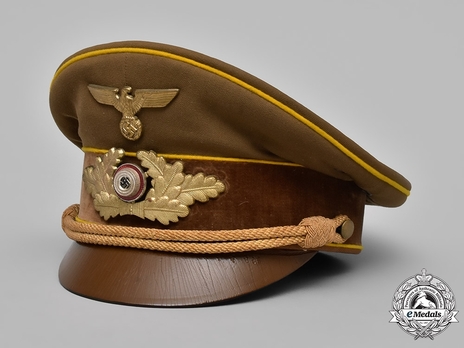
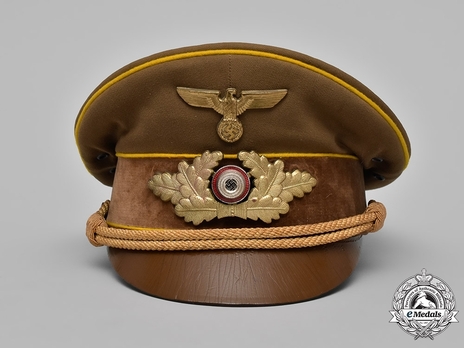
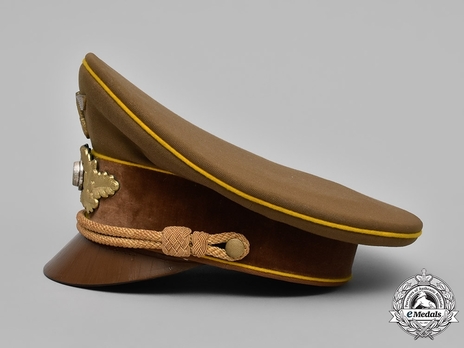
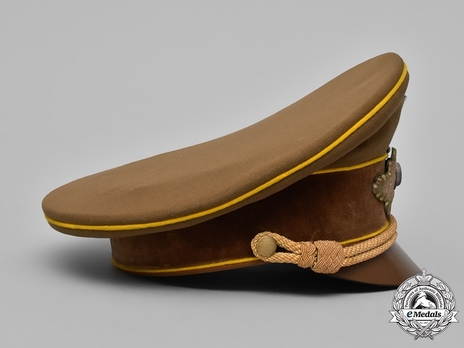
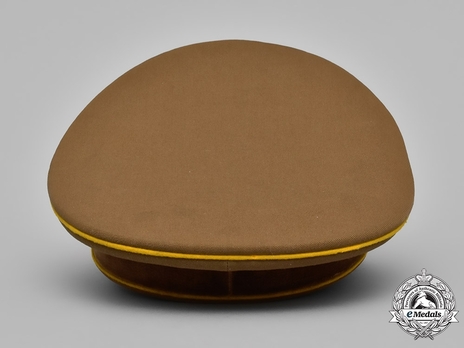
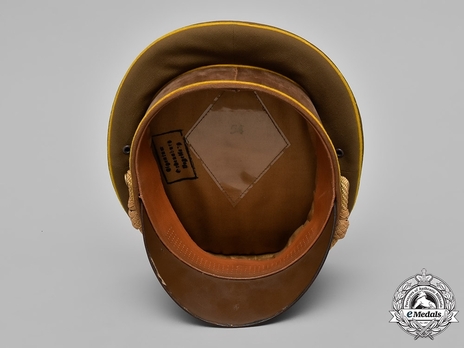
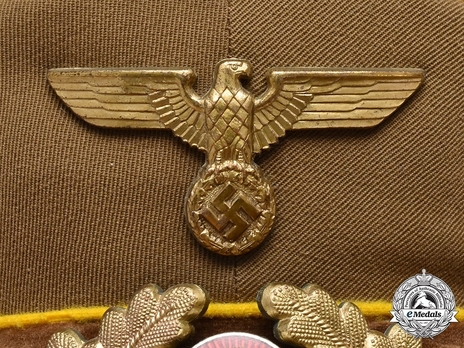
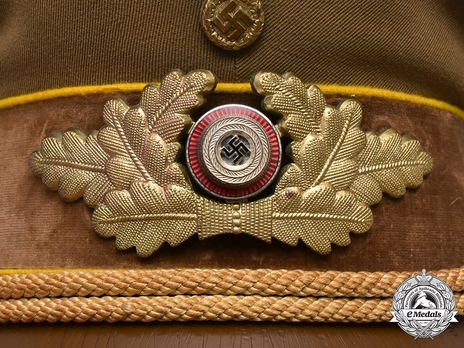
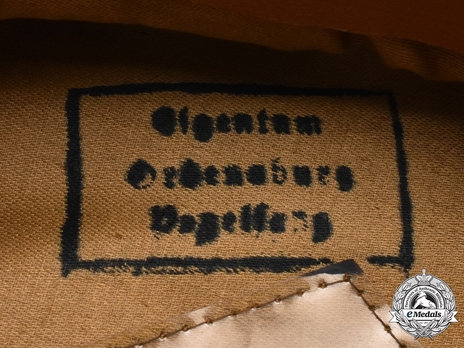
Estimated market value:
This is an extremely well-preserved example of a NSDAP Reichsleitung-level visor cap, constructed of tan-coloured, webbed fabric with a traditional high peak and three bands of golden-yellow piping. The cap features a fully intact band constructed of a light brown doeskin wool. Pinned into the peak of the cap is an insignia in the form of a NSDAP-style German national eagle clutching a wreathed mobile swastika, constructed of gilded bronze and measuring 65 mm (w) x 33 mm (h). Pinned into the cap band underneath the eagle is a cockade and wreath, each constructed of gilded bronze, with the former surrounded by a red enameled ring and bearing a central black enameled mobile swastika. The cockade and wreath measure 110 mm (w) 45 mm (h). The cap is flanked by pebbled, gilded, magnetic metal buttons holding in place a two rows of twisted and rolled gold bullion cords, neatly knotted at each end, which rest upon the visor. The visor is constructed of brown lacquered vulkanfibre and is securely stitched into the body of the cap. The cap is also flanked by sets of dual ventilation holes with reinforced brown bakelite eyelets. The interior of the cap features a brown leather sweatband, 43 mm in thickness, securely set in place with a row of machine stitching. Multiple rows of stamped ventilation holes are set into the sweatband at the front of the cap. The interior also features a complete tan-coloured rayon liner, bearing a transparent plastic rhomboid moisture guard, over top of a size mark of “54” in clearly-visible black ink. Adjacent to the moisture guard is a black ink stamp clearly reading “Eigentum Ordensburg Vogelsang”, indicating that the cap was the property of the NSDAP political training school located in the Eifel Mountains. Similarly, the interior of the cap band bears black ink stamps reading “8X” and “GJ36”. The cap is otherwise unmarked and measures 230 mm (w) x 265 mm (l) x 155 mm (h). There is some minor tarnishing of the bronze wreath, as well as fatigue to the visor, but the cap is in an otherwise extremely fine condition.
Footnote: This visor cap appears as the model used as an exemplar for the NSDAP Reichsleitung-level cap in “German Headgear in World War II: SS, NSDAP, Police, Civilian, and Miscellaneous”, 1997, by Pat Moran and John Maguire, pages 72-73.
The uniforms, headgear, and insignia of the National Socialist German Workers’ Party (Nationalsozialistische Deutsche Arbeiterpartei or NSDAP) went through several design changes from 1933 until the end of the Second World War. Dr. Ley, originally the Gauleiter of Rheinland and later promoted to the position of chief of staff of Party Organization and Reich Organization Leader, was largely responsible for the NSDAP rank system and uniforms.
The standardized production and circulation of all NSDAP uniform garments, headgear, and insignia were overseen by the National Material Control Office (RZM or Reichszeugmeisterei). The RZM was created in July 1934, and it was located in Munich. From 1935 onward, all NSDAP uniform garments and insignia were legally required to feature an RZM control mark or tag, as well as a number mark on metal insignia or belt buckles. These marks indicate the authenticity of the object, the type of insignia or garment, and identify the manufacturer.
The first attempt to standardize the NSDAP headgear began in 1933. The visor caps worn by NSDAP members underwent several iterations from 1933 until the end of the Second World War.
All versions of the cap were produced from a brown coloured material, with a brown velvet or velveteen cap band.
The first formalized version of the visor cap replaced the informal NSDAP Kepi style cap. It was officially introduced on January 20, 1934, hence it is being referred to as M(odel) 34. It can be found in the stiffer so-called "saucer" form (Tellermütze), which uses an internal wire to keep the shape of the cap, or the more relaxed so-called "old style" form (Klappmütze), which does not feature an internal wire and is therefore foldable.
Buttons and chin cords are either gold-coloured or silver-coloured, depending on the wearer's rank and position. However, gold-coloured chin cords were usually accompanied by gold-coloured buttons, and silver-coloured chin cords by silver-coloured buttons.
This cap features a small, silver-coloured national emblem eagle above the cap band and along the front seam, as well as the national tricolour cockade in the centre of the cap band. The visor of the M34 is generally produced from dark brown leather (sometimes black, but this was against regulations).
Piping was worn along the crown and above and below the cap band to identify the wearer’s political rank level. Piping colours include yellow for Reichsleitung level (national), red for Gauleitung level (larger district (Gau) level), black for Kreisleitung (district level), and light blue for Ortsgruppenleitung (local level).
Small changes were made constantly, but in 1939, a new design of the visor cap was introduced, known as the M39 cap.
The piping colours for the M39 were specified as golden-yellow for Reichsleitung level, dark red for Gauleitung level, white for Kreisleitung level, and light blue for Ortsgruppenleitung level.
Chin cords and buttons were gold-coloured for every rank. So was the national eagle emblem insignia. The tricolour cockade was now framed by an oak leaf wreath insignia.
Lastly, a cap with a white top for summer wear was introduced. The summer cap did not feature piping on the crown, only above and below the cap band.

Comments
Sign in to comment and reply.


Scroll Top